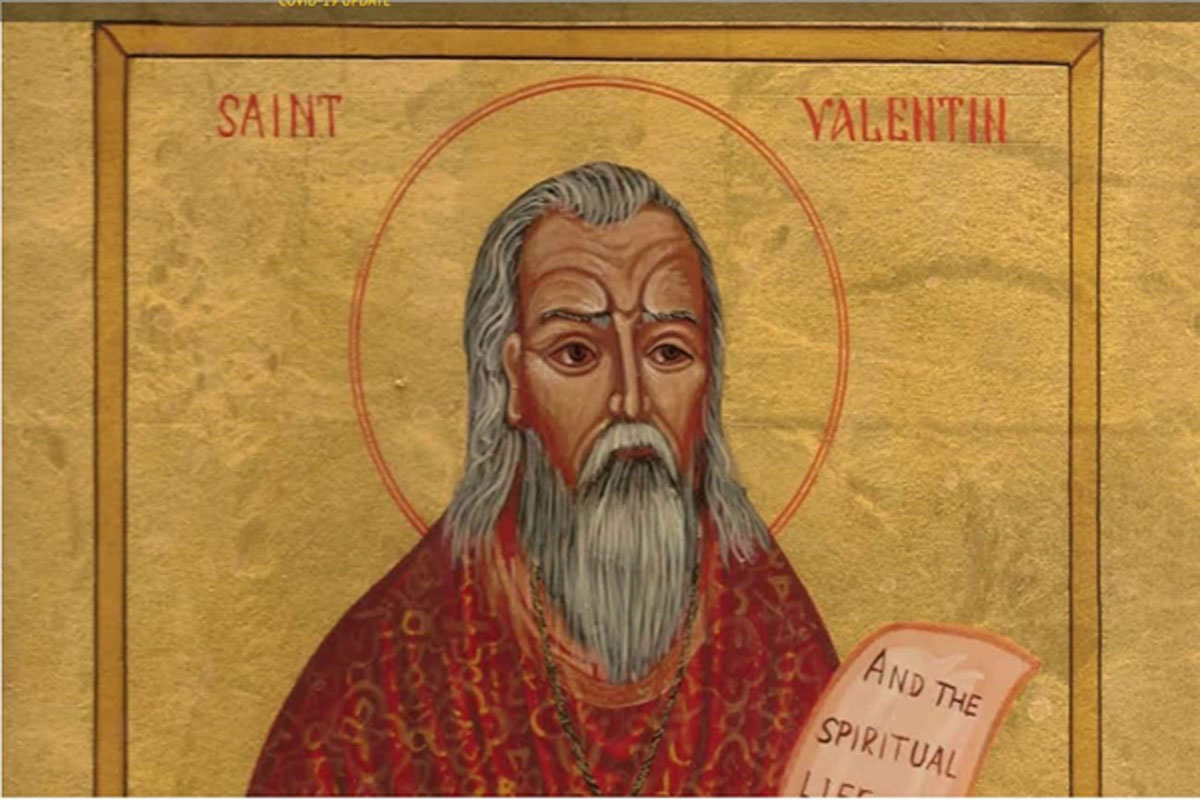
The Dark (And Surprisingly Convoluted) Origins Of Valentine’s Day
TGWritesitems
January 26, 2023
In the 21st century, some view Valentine’s Day as a holiday to celebrate love in all its forms (although primarily romantic love), while others deride it as an overly commercialized holiday that is focused more on boosting the sales of flowers, candy, greeting cards, and jewelry than it is on celebrating love.
When the holiday rose to prominence in the Middle Ages, it was definitely focused on the ideas of love and romance. It was also dedicated to honoring the saint for which the holiday was named – a 3rd century martyr (or martyrs) named Valentinus (Valentine), the patron saint of (among other things) lovers, engaged people, and happily married couples.
The thing is, there is little historical evidence that Valentinus had any interest in love or romance. In fact, the history surrounding the man (or men – it is unclear whether the martyred Saint Valentine was one person or two) is very dark, as according to legend he was imprisoned and then beheaded by order of Emperor Claudius II, most likely because he attempted to convert pagans to Christianity. A couple hundred years later, Pope Gelasius I declared February 14 – the day that Valentinus was executed – to be the martyr’s saint’s day.
So how did we get from those dark origins to the traditions surrounding the current Valentine’s Day? Hopefully, this article will provide some answers.
________________________________________
• Photo: http://interestingliterature.com / Wikimedia Commons / CC0
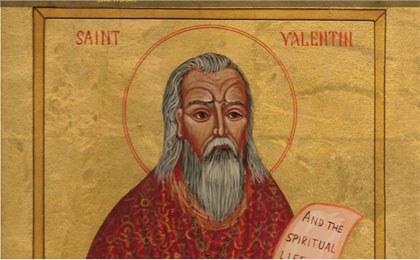 Valentine’s Day May Be Named For Two (Or Possibly Three) Men Who Were Executed In The 3rd Century CE
Valentine’s Day May Be Named For Two (Or Possibly Three) Men Who Were Executed In The 3rd Century CE
The origins of Valentine’s Day are a bit murky, as the historical records are incomplete and sometimes contradictory.
There are at least three Saint Valentines listed under the date of February 14 in the early martyrologies. All of them lived in the 3rd century CE; one was a priest who resided in Rome, and another was a bishop in Interamna (now Terni). There is little known about the third Saint Valentine, other than he reportedly was killed along with 24 soldiers in Africa.
• Photo: Jacopo Bassano (Jacopo da Ponte) / Wikimedia Commons / Public domain
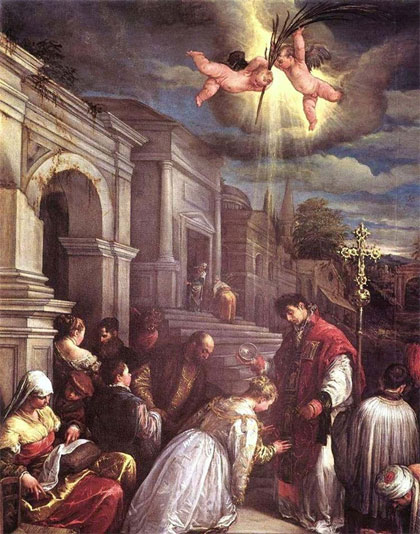 One Valentine Legend Dates Back To Ancient Rome, When A Priest Cured A Pagan’s Blindness
One Valentine Legend Dates Back To Ancient Rome, When A Priest Cured A Pagan’s Blindness
One legend states that a Roman priest named Valentinus was arrested and placed under the custody of an aristocrat named Asterius. During his confinement, the priest would talk to Asterius about how Christ led pagans out of darkness and into the light of salvation. Asterius promised that he and his family would convert to Christianity if the priest could cure his daughter of her blindness.
The legend claims that after the priest put his hands over the girl’s eyes and recited, “Lord Jesus Christ, enlighten your handmaid, because you are God, the True Light,” she could see. With his daughter cured, Asterius kept his part of the bargain, and he and the rest of his family were baptized.
When Emperor Gothicus (AKA Claudius II) learned of this, he ordered the execution of the priest, Asterius, and Asterius’s entire family. After Valentinus was beheaded, a woman made off with his body and had it buried on the Via Flaminia.
• Photo: Giovanni Battista de’ Cavalieri / Wikimedia Commons / CC0
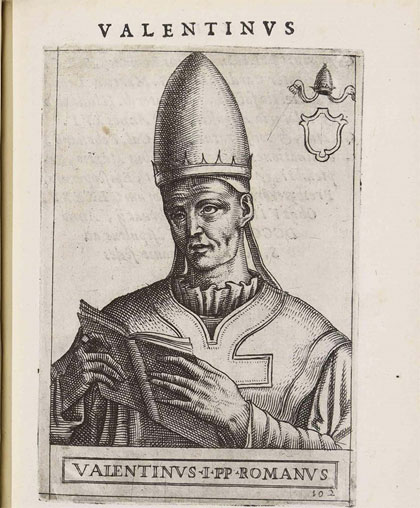 Another Legend Suggests Valentinus Was Executed For Converting Pagans To Christianity
Another Legend Suggests Valentinus Was Executed For Converting Pagans To Christianity
There is another legend about Valentinus that follows many of the same beats as the first. In this version, instead of a priest, Valentinus is a bishop in the Italian province of Umbria. He, too, allegedly convinced a man to convert to Christianity after curing the man’s son of some affliction, and he, too, was executed for angering the emperor. He was then buried on Via Flaminia.
A group of Belgian monks known as Bollandists spent three centuries (from the early 1600s to 1940) researching the lives of saints. They believed that, because of the similarities in the stories about the Roman priest Valentine and the Bishop Valentine, it is very possible that they were the same man, not two separate individuals.
• Photo: Giovani Dall’Orto / Wikimedia Commons / Public domain
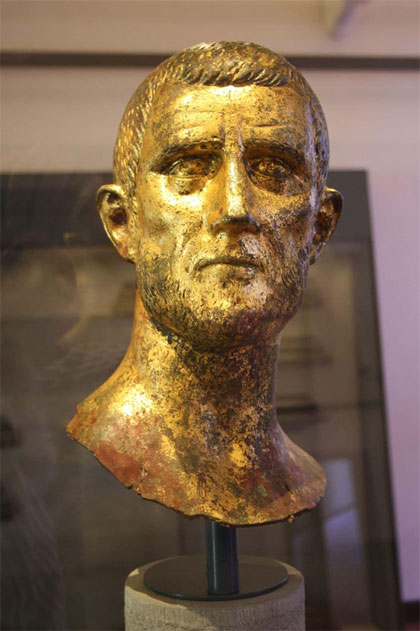 Still Another Legend Claims Valentinus Disobeyed The Emperor By Performing Marriages For Soldiers
Still Another Legend Claims Valentinus Disobeyed The Emperor By Performing Marriages For Soldiers
Another tale suggests the priest Valentinus was executed not because he attempted to convert Romans to Christianity, but because he disobeyed a law concerning marriage.
Emperor Claudius II was convinced that single men made better soldiers than those who had wives and families. So he outlawed marriage for young men. But the priest continued to marry couples, defying the law. As a result, the emperor ordered the priest’s execution.
• Photo: Wellcome Images / Wikimedia Commons / CC-BY 4.0
 While Imprisoned, Valentinus May Have Sent The First ‘Valentine’ Letter
While Imprisoned, Valentinus May Have Sent The First ‘Valentine’ Letter
In yet another variation on the legend of Valentinus, we are told he was executed because of his attempts to help Christians escape from Roman prisons, where they were often tortured.
In this story, the imprisoned Valentinus falls in love with a girl – possibly the daughter of his jailer – who comes to visit him. He sends her a love letter signed “from your Valentine.”
• Photo: Rijksmuseum / Wikimedia Commons / Public domain
 Valentine’s Day May Have Been Created As a Christian Replacement For The Pagan Holiday Of Lupercalia
Valentine’s Day May Have Been Created As a Christian Replacement For The Pagan Holiday Of Lupercalia
The pagan Feast of Lupercalia was celebrated from February 13 through 15. During the feast, Roman men would sacrifice a goat and a dog and then whip pregnant women with the skins of these animals.
The belief was that, by doing so, the woman would give birth to a healthy child. The celebration also included a lottery where a man would draw a woman’s name out of a jar and the two would then couple for the remainder of the feast – or longer, if the match was successful.
Some reports claim that in the year 467 Pope Hilary demanded that Emperor Anthemius abolish the festival. However, other historical records state that the Pope simply warned the emperor against tolerating heresies, and the festival continued to be held all through that emperor’s reign.
Then in 496, Pope Gelasius I denounced the Festival of Lupercalia as un-Christian and declared February 14th to be St. Valentine’s Day in honor of the 3rd century martyr(s). However, it would be hundreds of years before February 14th would become a holiday that celebrated love and romance.
• Photo: National Library of Wales / Wikimedia Commons / Public domain
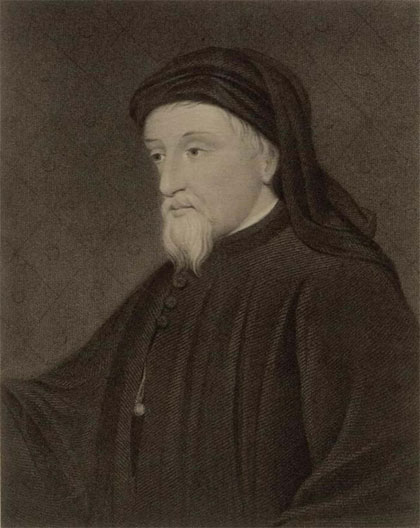 14th Century Poet Geoffrey Chaucer May Have Been First To Record That February 14 Should Be A Day Of Romance And Celebration
14th Century Poet Geoffrey Chaucer May Have Been First To Record That February 14 Should Be A Day Of Romance And Celebration
Although Valentine had already been a favorite saint for hundreds of years, the romantic connection to the saint and February 14th really started during the Middle Ages. During this time, especially in England and France, February 14 was considered the beginning of mating season for birds.
In 1375, the English poet Geoffrey Chaucer wrote about this idea in his poem entitled “Parliament of Foules.” The poem was written to commemorate the marriage of King Richard II and Anne of Bohemia:
For this was on Seynt Valentynes day,
Whan every foul cometh ther to chese his make,
This noble emperesse, ful of grace,
Bad every foul to take his owne place,
As they were wont alwey fro yeer to yere,
Seynt Valentynes day, to stonden there.
• Photo: Frank Bernard Dicksee / Wikimedia Commons / Public domain
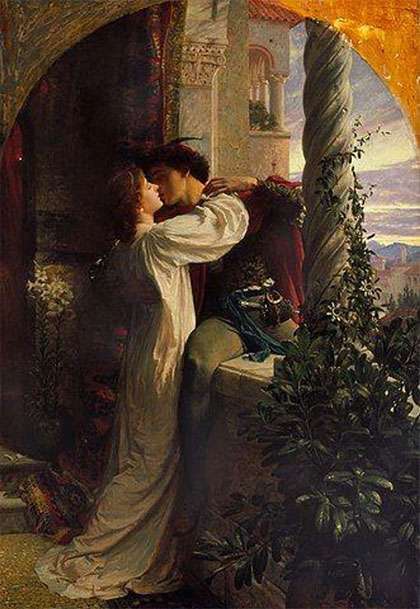 From the 14th To The 17th Century, It Was Customary For A Young Man To Draw A Name Out Of A Bowl To Choose His Valentine
From the 14th To The 17th Century, It Was Customary For A Young Man To Draw A Name Out Of A Bowl To Choose His Valentine
One Valentine’s Day tradition that was likely copied from the pagans involved the way in which valentines were chosen. During the Feast Of Lupercalia, a lottery would be held in which pagan men drew a woman’s name out of a jar. The two would remain together for the remainder of the festival, and possibly longer if the match was successful.
In the 14th century, it was common for a young man to choose his female valentine by drawing a slip of paper with a name on it out of a bowl. The lottery crossed class boundaries, which meant, for example, that a servant’s name could be drawn to be her employer’s valentine. This practice remained popular through the 17th century.
Video: YouTube
 The Oldest Known Surviving Love Letter Was Written By A Woman Named Margery Brews In 1477
The Oldest Known Surviving Love Letter Was Written By A Woman Named Margery Brews In 1477
Although one legend suggests that St. Valentine may have sent the first-ever valentine’s message, the oldest known surviving love letter written in English was penned by a woman named Margery Brews to her fiancé John Paston in February 1477.
In the letter, she refers to him as “[r]ight reverent and worshipful and my right well-beloved valentine,” and expresses her hope that they will be married even though she had been unable to persuade her father to increase her dowry (the couple did eventually get married).
• Photo: Hans Holbein the Younger / Wikimedia Commons / Public domain
 In 1537 Henry VIII Issued A Royal Charter To Officially Declare Valentine’s Day A Holiday In England
In 1537 Henry VIII Issued A Royal Charter To Officially Declare Valentine’s Day A Holiday In England
It should come as no surprise that King Henry VIII was a romantic; after all, the man was married eight times. The king wrote many love letters in his time, especially to his ill-fated second wife Anne Boleyn.
Considering his propensity for falling in love, it makes sense that in 1537 Henry VIII issued a Royal Charter that made Valentine’s Day an official holiday in England.
• Photo: Dave / Flickr / CC-BY-ND 2.0
 Valentine’s Day Cards Gained Popularity By The 16th Century
Valentine’s Day Cards Gained Popularity By The 16th Century
There is some belief among historians that a 1415 poem written by Charles, the French Duke of Orleans, to his wife was the first Valentine’s Day card (while imprisoned in the Tower of London, no less). In the poem, he expressed that he was “already sick of love” (i.e., “lovesick”) and called his wife his “very gentle Valentine.”
By the 16th century, sending Valentine’s Day cards had become a tradition; so much so that some religious leaders spoke out against the custom.
Despite that opposition, exchanging Valentine Day’s cards continued to grow in popularity. By the early 19th century, it had become the most popular way to express one’s feelings to a loved one on Valentine’s Day.
• Photo: James Saunders / Flickr / CC-BY-SA 2.0
 The Gifting Of Flowers, Especially Roses, On Valentine’s Day First Became Popular In The 17th Century
The Gifting Of Flowers, Especially Roses, On Valentine’s Day First Became Popular In The 17th Century
Legend claims that the rose was the favorite flower of Venus, the Goddess of Love, because the flower was supposed to represent strong feelings.
Beginning in the 17th century, people began giving flowers, especially roses, on Valentine’s Day to the people they cared about in order to express their feelings – a custom that has continued to this day
• Photo: Joe Haupt / Flickr / CC-BY 2.0
 Hallmark Offered Its First Valentine’s Day Cards In 1913
Hallmark Offered Its First Valentine’s Day Cards In 1913
Valentine’s Day is the second-most popular holiday in the United States (behind only Christmas) when it comes to sending cards to mark the holiday. In 2020, an article in the Washington Post estimated that 145 million Valentine’s Day cards would be sent out by US residents that year – and that didn’t include the cards that some classrooms gave to students to exchange.
Of course the United States is not the only country where this holiday is celebrated; Valentine’s Day is also officially recognized as a holiday in Canada, the United Kingdom, Mexico, Denmark, France, Italy, and Australia.
Hallmark, one of the biggest greeting card manufacturers in the world, first offered Valentine’s Day cards in 1913, although it didn’t start producing them until 1916.
• Photo: Jo N / Flickr / CC-BY 2.0
 The Catholic Church Halted Liturgical Veneration Of St. Valentine In 1969
The Catholic Church Halted Liturgical Veneration Of St. Valentine In 1969
The saint connected to Valentine’s Day is officially referred to as St. Valentine of Rome in order to distinguish him from the dozen or so other individuals who are on the Catholic Church’s official list of recognized saints named Valentine (or some variation thereof).
Because there is so much confusion about the real identity of the 3rd century St. Valentine, the Catholic Church stopped its liturgical veneration of him back in 1969, although he remains on the list of individuals officially recognized as saints. In addition to being the patron saint of lovers, engaged persons, and happily married couples, he is also the patron saint of bee keepers, travelers, and for people suffering from epilepsy, fainting, and the plague.
ranker.com

















